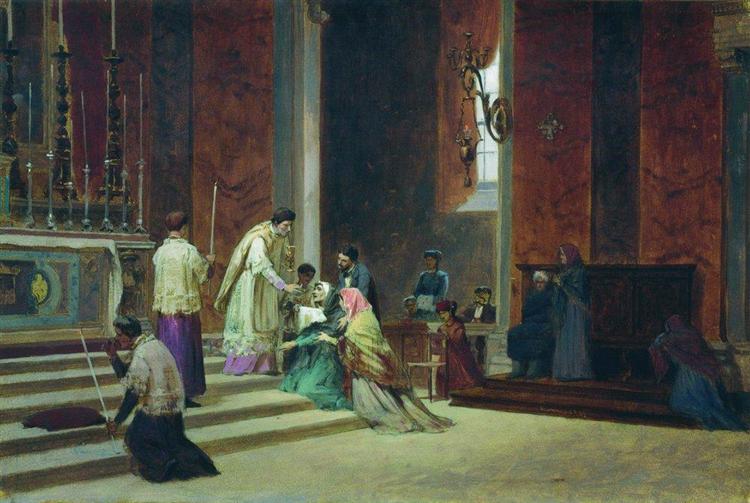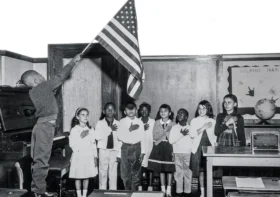Every Mass a Life

The Catholic Mass (1869) by Fedor Andreevich Bronnikov
It is a rare thing to capture life in a moment, but when we do, we find one foot on earth and the other curiously in Heaven. Nowhere is this more true than in the sacrament of Mass. Indeed, unlike any other transcendent experience, the Mass contains the whole breadth and depth of life. It is active and passive, spirit and matter, communal and personal, common and extraordinary, joy and sorrow, now and eternal. It is birth and death and resurrection, again and again.
When a Catholic walks into her parish, she enters the bosom of Mother Church. At the threshold, she dips a finger in holy water and crosses herself. In doing so, she remembers and relives her baptism when she was “born again”. She may even recall the trials and the wrestling with God—in a word, the labor pains—that precipitated her baptism. Now, she is allowed to rest from the world; she is at home.
Taking a pew, she waits to meet the priest as passively as a newborn babe awaiting the arms of her father. The priest enters in a procession with Christ lifted high, strengthening the baby’s young neck to hold up her head to Heaven.
After the greeting, she has aged to toddlerhood when a child first begins to sin. Those sins must be accounted for, and they are in the Penitential Act, the Kyrie, and the Gloria. At this time, she makes her apology, he forgives her, and she sings of how good the Father is. Reconciliation has occurred, and she may grow up further.
Entering the Liturgy of the Word, the woman in the pew has aged to young childhood. She is sung to from the psalms, and to her ears they are as lovely as nursery rhymes.
Next it is storytime, the Scripture readings. She hears fairytales of old from the Old Testament, tales of honor and beauty; she hears wisdom from an Epistle; then the “true myth”, the Gospel.
As any good Father would, he invites his child to recite what she has learned. And so she does in the Creed.
Then, just like before any meal, the Father leads his family in prayer. But this is no ordinary meal, for the woman has aged further still. She looks on the consecration of the Host as a woman in young adulthood, and this is her marriage feast. Before her is her bridegroom, the transubstantiated bread and wine. She has been kneeling for some time, preparing her soul for union.
At last, she is ready to walk down the aisle to her groom. The vail she donned on arrival now takes on a whole new purposes as she stands at the altar. She receives him, and they are one. She is now “Through him, with him, in him, in the unity of the Holy Spirit […]”. Upon this consummation, she receives the seed of eternal life, his seed. With faith, hope, and charity, this seed will grow to bear much fruit. But that fruit is not meant for her; it is for the starving world outside.
She returns to her seat and, rapt in His glory, kneels again, only this time she has aged further still. She closes her eyes, bows her head, and folds her hands—the exact pose she would assume in a coffin. This is fitting for she joins Christ her bridegroom as he is entombed within the tabernacle just as he was entombed after His original sacrifice. While all this takes place, she is praying fervently. Her soul is lifted to Heaven just as surely as Christ was ascended there. There she and He will enjoy an eternal honeymoon.
But this is only a fleeting foretaste, for her time has not come yet. For now, she must wait patiently, receiving one last blessing from the priest before being sent into the world again. In a manner of speaking, she has been resurrected. She has lived the whole life-cycle of a saint in the Mass, and yet the Mass has infused her with a newness of life. With it, she now is commissioned to bring the Heaven she tasted to earth. That is, until she comes back next Sunday, a babe once more.




Leave a Reply